
About UsThe Numismatic Bibliomania Society is a non-profit organization promoting numismatic literature. For more information please see our web site at coinbooks.org SubscriptionsThose wishing to become new E-Sylum subscribers (or wishing to Unsubscribe) can go to the following web page link MembershipThere is a membership application available on the web site Membership Application To join, print the application and return it with your check to the address printed on the application. Membership is only $15 to addresses in the U.S., $20 for First Class mail, and $25 elsewhere. For those without web access, write to: David M. Sundman, Secretary/TreasurerNumismatic Bibliomania
Society AsylumFor Asylum mailing address changes and other membership questions, contact David at this email address: dsundman@LittletonCoin.com SubmissionsTo submit items for publication in The E-Sylum, just Reply to this message, or write to the Editor at this address: whomren@coinlibrary.com
BUY THE BOOK BEFORE THE COINYou won't regret it! |
- WAYNE'S WORDS: THE E-SYLUM JANUARY 16, 2011
- KOLBE & FANNING 2011 NEW YORK SALE RESULTS
- SKLOW MAIL BID SALE NO. 12 CLOSES FEBRUARY 12, 2011
- NEW BOOK: A GUIDE BOOK OF GOLD DOLLARS, 2ND EDITION
- NEW BOOK: STANDARD CATALOG OF GERMAN COINS, THIRD EDITION
- BOOK REVIEWS: A GUIDE BOOK OF FRANKLIN & KENNEDY HALF DOLLARS
- BOOK REVIEW: ASTRONOMICAL SYMBOLS ON ANCIENT & MEDIEVAL COINS
- BOOK REVIEW: STANDARD CATALOG OF GERMAN COINS, THIRD EDITION
- ANA EDUCATIONAL EVENT: MINTING & MINING IN CARSON CITY
- QUERY: WHERE IS THE HAINES 1823/2 QUARTER?
- QUERY: IMAGES OF ENGRAVER WILLIAM BARBER SOUGHT
- QUERY: NUMISMATOURIST HOWARD BERLIN SEEKS TRAVEL DESTINATIONS
- MORE ON THE TENURE OF U.S. MINT DIRECTORS
- WHERE ARE THE ELECTRONIC NUMISMATIC BOOKS?
- DIGITAL LIBRARY NUMIS UPDATE
- CAN A PUBLISHER BE SUED FOR ERRORS IN A BOOK?
- NOTES FROM E-SYLUM READERS: JANUARY 16, 2011
- MORE ON THE SHERATON COIN COMPANY
- QUERY ANSWER: ANA HALL OF FAME BIRTH, DEATH DATES
- JOHN SINNOCK AND THE PURPLE HEART
- PARKS CANADA COIN DESIGNER LUC NORMANDIN
- MCLEANS PUBLISHES A TRIBUTE TO THE CANADIAN CENT
- AN 1864 WATT AND COMPANY HONG KONG TRIAL PIECE
- THE MOST BEAUTIFUL DEPICTION OF A SHIP IN NUMISNAUTICS
- C-SPAN VIDEO: HISTORY OF U.S. CURRENCY
- FEATURED WEB PAGE: GERMAN STATES COINS
WAYNE'S WORDS: THE E-SYLUM JANUARY 16, 2011

We have no new subscribers this week. We have 1,393 email subscribers, plus 111 followers on Facebook, including Bruce W. Smith.
This week we open with notes from George Kolbe and David Sklow with information on their recent and upcoming numismatic literature sales. Next, we have announcements of two new books and four reviews.
Other topics include 1823/2 quarters, engraver William Barber, electronic books and the Sheraton Coin Company. To learn more about Ultra Cameo Proofs, Mint Director Eva Adams, Digital Library Numis, John Sinnock and the Purple Heart, and a chocolate filled medal of President Kennedy, read on. Have a great week, everyone!
Wayne Homren
Numismatic Bibliomania Society
KOLBE & FANNING 2011 NEW YORK SALE RESULTS
 On Saturday, January 8, 2011, Kolbe & Fanning Numismatic Booksellers LLC conducted their 120th sale of rare and out-of-print numismatic literature, a public auction at the Waldorf Astoria Hotel in New York City in conjunction with the New York International Numismatic Convention. Featured were 500 lots on a great variety of topics, including rare works on Russian coins and medals from the Dr. Ira Rezak Library, highlights from the outstanding Latin American Numismatic Library formed by Alan Luedeking, and other important works covering the numismatic spectrum.
On Saturday, January 8, 2011, Kolbe & Fanning Numismatic Booksellers LLC conducted their 120th sale of rare and out-of-print numismatic literature, a public auction at the Waldorf Astoria Hotel in New York City in conjunction with the New York International Numismatic Convention. Featured were 500 lots on a great variety of topics, including rare works on Russian coins and medals from the Dr. Ira Rezak Library, highlights from the outstanding Latin American Numismatic Library formed by Alan Luedeking, and other important works covering the numismatic spectrum.
Ninety percent of the lots in the sale sold, bringing nearly 150% of the total of their estimates, or an average of well over $1,000 per lot.
Kolbe & Fanning are already planning for a January 2012 New York Sale and those interested in consigning outstanding works are invited to contact David Fanning or George Kolbe. Less important works can be sold during the course of 2011 with highlights reserved for public sale in the numismatic capital of the world in January 2012. Interested parties are invited to contact David Fanning at df@numislit.com or (614) 414-0855 and George Kolbe at gfk@numislit.com or (909) 338-6527.
Some January 8, 2011 sale highlights include: an original set of Babelon's masterwork, Traité des Monnaies Grecques et Romaines, sold for $23,000 on a $5,000 estimate and the de Morgan continuation, estimated at $1,750, brought $7,475 (results cited include the 15% buyer premium); Brenner's classic 1731 work on Swedish coins and medals garnered a winning bid of $1,380; a nice set of Eckhel's 1792–98 eight-volume work on ancient Greek and Roman coins was estimated at $1,500 and brought $3,737; a fine example of the legendary 1905 Jacob Hirsch catalogue of the Rhousopoulos sale of Greek coins, annotated by the famous American coin dealers, the Chapman brothers, went for $3,450 on a $1,500 estimate; and a superb set of the famous 1791 Beskrivelse over Danske Mynter og Medailler was estimated to bring $7,500 but sold for $13,800.
The fine selection of pre-revolutionary works on Russian coins and medals sold extremely well, bringing close to three times the estimates, and was highlighted by a handsome set of the 1916 French edition of Georges Michaïlovitch's Monnaies de l'Empire de Russie, which realized $25,300.
The 144 lots comprising highlights from the Alan Luedeking Latin American Numismatic Library brought well over estimate. The second part of the extensive Luedeking library will be sold in early June 2011 by Kolbe & Fanning.
The American section of the sale, comprising slightly over 100 lots had its share of excellent results. A few worth mentioning include the 1875 Crosby family copy of The Early Coins of America, in a deluxe Nova Constellatio three-quarter morocco binding. Originally, it undoubtedly belonged to author Sylvester Sage Crosby and it was hotly contested for, realizing $34,500 on a $12,500 estimate.
Kenyon Painter's plated 1920 Thomas Elder sale of the Henry C. Miller collection was estimated to bring $2,500 but realized $8,625, and the numismatic correspondence files of Chicago numismatist and bibliopole Michael Powills, estimated at $5,000 were sold after spirited floor and telephone bidding for $27,600.
In April, Kolbe & Fanning plan to issue an extensive fixed price list featuring numismatic books, auction catalogues, and periodicals and, as previously mentioned, the firm will conduct a large mail-bid sale on June 2 as well as two additional sales later in the year. Inquiries may be made by contacting Kolbe & Fanning Numismatic Booksellers LLC, 141 W. Johnstown Road
SKLOW MAIL BID SALE NO. 12 CLOSES FEBRUARY 12, 2011
MAIL BID SALE NO. 12 CLOSES FEBRUARY 12, 2011
PART FOUR OF "THE MASTER OF WOLFEBORO"
Q. DAVID BOWERS RESEARCH LIBRARY
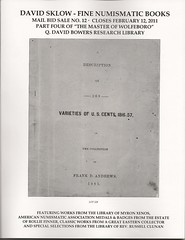 From the research & source library of Q. David Bowers comes seventy-five lots of historical works and a touch of numismatics.
From the research & source library of Q. David Bowers comes seventy-five lots of historical works and a touch of numismatics.
The sale also features classic selections from the library of numismatic publisher and literature dealer Myron Xenos, to include bound volumes of The Numismatist 1894-1936 and a long run of over sixty Chapman catalogs.
Over three thousand full color photographs of U. S. Large Cents 1793-1814 by William Noyes.
The very rare 1881 first edition of Frank Andrews work on U. S. Large Cents 1816-1857 serial number 22 of 40 published with only 6-8 known.
Libraries from the West Coast and the East Coast; featuring deluxe bound auction catalogs and special presentation editions, some in original full leather.
Badges & Medals of the American Numismatic Association from the estate of Rollie Finner.
Bidders may enter bids by mail, telephone, email or fax. The sale closes at 8pm mountain time, February 12, 2011, however, any bids left on our answering machines or sent by email or fax on or before midnight on closing day will be accepted.
Catalog is viewable on our website
Individuals on our mailing list will have already received their catalogs Catalogs are available upon request at no charge.
DAVID SKLOW – FINE NUMISMATIC BOOKS P.O. BOX 6321 COLORADO SPRINGS, CO 80934 TEL: (719) 302-5686 FAX: (719) 302-4933 finenumismaticbooks@aol.com www.finenumismaticbooks.com
NEW BOOK: A GUIDE BOOK OF GOLD DOLLARS, 2ND EDITION
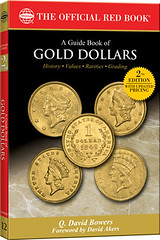 Whitman Publishing has released the second edition of A Guide Book of Gold Dollars, by Q. David Bowers, with a foreword by David Akers. The 288-page book has a retail price of $19.95 and is available online (including at WhitmanBooks.com) and from booksellers and hobby stores nationwide.
Whitman Publishing has released the second edition of A Guide Book of Gold Dollars, by Q. David Bowers, with a foreword by David Akers. The 288-page book has a retail price of $19.95 and is available online (including at WhitmanBooks.com) and from booksellers and hobby stores nationwide.
United States gold dollars are a fascinating and highly collectible series. In A Guide Book of Gold Dollars, Q. David Bowers—the "Dean of American Numismatics" and the most prolific numismatic author of all time—shares tips for smart collecting: how to evaluate quality, determine value, understand the market, and make good buys. Along the way Bowers explains why, "in all of American numismatics, the gold dollar possesses a special charm."
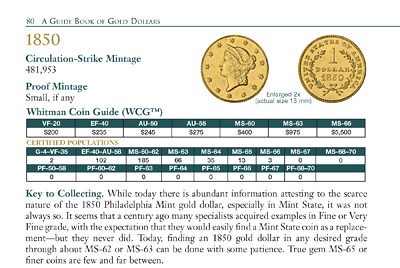
 Readers learn how the history of the nation shaped the coin's design and production—how the first gold dollars were made by a private coiner from gold mined in Georgia; why some thought only second-rate countries issued such small gold coins; what the public thought of the tiny, delicate, yet highly practical coins; and the effects the Gold Rush, the Civil War, political controversy, monetary crises, and other factors had on the coinage.
Readers learn how the history of the nation shaped the coin's design and production—how the first gold dollars were made by a private coiner from gold mined in Georgia; why some thought only second-rate countries issued such small gold coins; what the public thought of the tiny, delicate, yet highly practical coins; and the effects the Gold Rush, the Civil War, political controversy, monetary crises, and other factors had on the coinage.
Bowers provides a wealth of information on each issue: mintages, certified populations, field populations (number of surviving coins), grading information, die characteristics, market values, auction records, keys to collecting, and more. Enlarged photographs illustrate each date and mintmark. A historical backdrop of what was going on in America during each year, along with hundreds of full-color images, make this book a treat for anyone interested in our nation's history.
Gold expert David W. Akers calls the Guide Book of Gold Dollars "a wonderful book—in fact, the finest volume that Dave Bowers has yet written in the Official Red Book series."
Author: Q. David Bowers
ISBN 079483241-5
Full color, illustrated. 6 x 9 inches. Softcover.
Retail $19.95
NEW BOOK: STANDARD CATALOG OF GERMAN COINS, THIRD EDITION
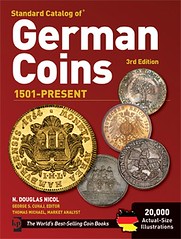 The Standard Catalog of German Coins is now available from Krause Publications. Noted German coin expert N. Douglas Nicol compiled the 1,500-page book, with George Cuhaj serving as editor and Tom Michael as market analyst.
The Standard Catalog of German Coins is now available from Krause Publications. Noted German coin expert N. Douglas Nicol compiled the 1,500-page book, with George Cuhaj serving as editor and Tom Michael as market analyst.
The third edition of this massive reference brings users a wealth of information covering more than five centuries of German coinage, all in one single, comprehensive volume. The Standard Catalog of German Coins offers accurate market values compiled through analysis of actual dealer offerings and auction results spanning the 12 years since the release of the second edition. Attribution is also improved with expanded descriptions and thousands of coin images.
Special features of this third edition include:
-Cross-referencing to specialized literature.
-Additional data on mint officials and mintage figures.
-An increased number of minor coin illustrations.
-Listings for German states that only existed prior to 1601.
-A brief overview of German monetary history by author N. Douglas Nicol.
-German coin denomination tables by Nicol.
For more information visit www.shopnumismaster.com/product/standard-catalog-of-german-coins .
Editor George S. Cuhaj is a 16-year veteran of Krause Publications' Numismatic Catalog Division, where he is also the editor of the Standard Catalog of® World Coins series. Cuhaj hails from New York City, where he was previously on staff with the American Numismatic Society, Stack's Rare Coins and R.M. Smythe & Co. He is a frequent instructor at the American Numismatic Association's Summer Seminars.
Market Analyst Tom Michael serves as market analyst for Krause Publications coin catalogs, and has done so for more than 90 world and U.S. coin catalogs. He has more than 20 years of experience researching and reporting on world coin prices and market trends. N. Douglas Nicol of Pennsylvania and Oxford, England, is an internationally known expert in world coins, particularly German states. He co-authored the previous two editions of the book.
BOOK REVIEWS: A GUIDE BOOK OF FRANKLIN & KENNEDY HALF DOLLARS
A Guide Book of Franklin & Kennedy Half Dollars by Rick Tomaska (Whitman Publishing LLC, 2011; 273 + x pages; $19.95)
Whitman continues to exceed the standards it sets. Designed to serve its substantive subject material, this new book will contribute to the growth of yet another new subgenre in American collecting. For at least 20 years, the median age in our hobby has been near 55. The Kennedy Half Dollar is almost 50 years old. Today's collectors do not remember Walking Liberties and the occasional V-Nickel. For them, the Franklin and Kennedy half dollars are history. Though delivering an expert analysis of each series by Date, Mintmark and Variety, this book bestows much more.
Despite the intention of mass production, no two coins are alike. Uncirculated and Proof coins are individuals. Author Rick Tomaska warns against assuming that you can find a coin "just as nice" for much less in an online auction. These are coins that truly must be seen to be appreciated. You can find them in sight-unseen auction, but gaining the true value in ownership requires that you know the histories of the grading standards better than you know the histories of the men on the obverses.
Tomaska explains the details of die and planchet preparation specific to these coins, including facts and speculations on the timings of the acid baths for the dies. Die material, the tempering of steel, press operation and maintenance, the repolishing of dies … all of this is the background to explain why the Ultra Cameo Proofs are so rare. The author's Acknowledgements nods to four mint employees: two press operators (Don Weaver and Mark Layfield); a die setter (Ed Fulwider); and a foreman (Mike Allphin).
At this level of quality, so close to perfection, a coin can be rejected for hairlines, planchet flow, being struck through lint, and having milk spots. Different standards apply to Cameo, Deep Cameo, and Ultra Cameo. A section on "The Upgrade Factor" tells the story of an NGC PF-67 Cameo 1950, a $15,000 beauty that became a $100,000 treasure when resubmitted, earning a PF-67 UC grade and being crowned the finest known 1950 by two points.
The Kennedy Half Dollar stands apart from the Franklin by several measures. The Special Mint Sets (1965-1967) and the Bicentennial issues earn consideration. Now, the most recent production, 1990-present, trivializes all but the perfect examples, with Proof-69 and Proof-70 being relatively easy to find, and Ultra Cameos bringing only a small premium over the issue price.
That paradigm explains why for each coin by year and Mint, the body of this book tabulates populations, not prices. Valuation is by adjective. Tomaska cites ranges - $800 to $2500, $1200 to $1500, or even $40 to $60 - noting that nicer examples can bring 25% to 50% more. Valuations are quantified and tabulated in Appendix B. Appendix A is a splash of high grade, Mint State and Proof rainbow toned Franklin and Kennedy half dollars.
Tomaska states a truism: unlike oil, no amount of new technology can unlock hidden reserves of these coins. That applies to colonial coppers, of course. And it may be that the aficionado of the one is not the maven of the other. If that speculation is accurate, one can only ask: Why not?
A Guidebook of Franklin and Kennedy Half Dollars is a 304 page soft cover book and is the 15th entry in Whitman's bestselling Bowers Series of numismatic reference books. Franklin and Kennedy half dollars are not only a popular series but very affordable.
The book gives detailed coin by coin information by date, mintmark and die variety for both Franklin half dollars and Kennedy half dollars. This study gives tips for smart buying along with variety characteristics and mintages and certified populations.
Rick Tomaska specialized in high grade proofs and cameo and deep cameo proofs as early as the 1980s. He also specialized in full bell lines on the Franklin half as well. The actual production of the coins including the preparation of the dies and planchets along with their influence on the finished coins is covered. A full color picture of every coin in the two series is also shown.
Nine pages of beautifully toned coins and their certified grade are also included for comparison. This book covers all the information you would ever want to know about the series.
For more information on this reference which sells retail for $19.95 you can contact the publisher at: Whitman Publishing, LLC, 3101 Clairmont Road, Suite G, Atlanta, GA 30329, Phone (404) 235-5300 or fax to (404) 235-5350 or visit the Whitman web page at: http:/www.whitmanbooks.com
BOOK REVIEW: ASTRONOMICAL SYMBOLS ON ANCIENT & MEDIEVAL COINS
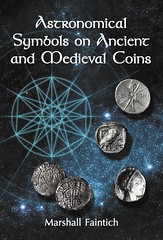 Marshall Faintich scores gold with his remarkable, 225 pp: Astronomical Symbols on Ancient & Medieval Coins. It is anything but your common-or-garden coin book.
Marshall Faintich scores gold with his remarkable, 225 pp: Astronomical Symbols on Ancient & Medieval Coins. It is anything but your common-or-garden coin book.
His work explores the notion that many astronomical symbols used on ancient coins record actual celestial events. The study is predicated on the use of coins by monarchs as a propaganda tool, one they used to demonstrate their divine right to rule.
Marshall is well placed to make such an analysis. He is, "an astronomer by training, a cartographer by trade, and a student of numismatics, archaeology, and history". His numismatic experience dates back 50 years. The results of his investigation of several hundred ancient coins are illustrated by some 550 line drawings, including maps and records of heavenly events.
The first four chapters examine representations on coins of the sun, moon, stars, planets, eclipses and comets, and of the events that may have prompted their incorporation into the coins' designs.
Following examination of out-of-left-field astronomical designs and assorted heavenly visions, three chapters look specifically at the coins of Norman England, Anglo-Gallic deniers, and the influence astronomical events held for the crusades, particularly that of Louis IX of France.
Both the introduction and the conclusion, that is not a conclusion but rather a beginning, are essential to understanding the rest of the book and Marshall's methodology. First and foremost Marshall is a scientist. He brings to his study the rigour of the scientific method. He well knows that correlation does not imply causation. His approach is spelt out on p. 5:
First, the date of a coin bearing an astronomical symbol must be ascertained. Second, the astronomical symbol must be the first occurrence for that coin design or a reintroduction of the symbol after a substantial period of time to rule out immobilization of the design. Third, the occurrence of the astronomical event must be established. Fourth, and most difficult to ascertain, historical evidence must be presented that supports the observance and importance of the event.
Much of the remainder of the book is concerned with applying this strategy to a remarkable range of European coins. Each study is something of a mini-detective story.
Typical is Marshall's analysis of a well trodden path: the two stars Type V penny of William I. He discounts Carolyn-Britton's interpretation that one star represents a comet of 1077 since no reliable sources identify a comet in that year. There was, however, one in 1075 and he explores that possibility that this is the comet recorded in the coin's design along with that of Halley's in 1066. That latter presaged William's success at Hastings. That of 1075 foretold his triumph over a revolt by English barons. William was no sluggard in exploiting coin designs as instruments of state propaganda. By depicting himself with two comets he declared his right to rule was written in the heavens.
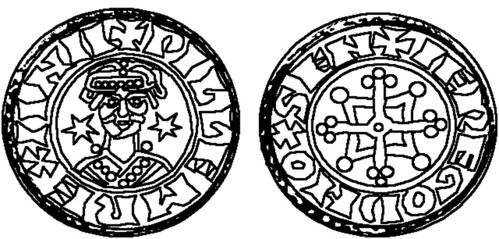
Typical line drawing as used to illustrate a Type V two star silver penny of William I.
Image courtesy McFarland & Company and Marshall Faintich.
Some analyses are highly detailed such as that of the three heavenly visions experienced by Constantine, a ruler prone to apparitions. I suggest readers ensure they are seated comfortably, have plenty of time to spare, and a goodly supply of coffee to hand before working their way through this one. It is a great yarn that needs careful reading. Of course, you are welcome to disagree. Marshall invites debate.
Each and every story is illustrated with clear line drawings, some of coins from Marshall's personal collection. By using such drawings the necessary detail is made clear and presented in a uniform manner. The same result and clarity could not have been achieved from photographs alone. In addition Marshall has used his cartographic skill and astronomical knowledge to bring us maps of the night sky for the appropriate dates. A typical example if that of the planetary alignment on 27 October 312 when Constantine beheld the first of his fiery crosses.
This is a book not be to read in a hurry. It is one to be savoured and digested at leisure. It makes no claims to be definitive. It simply represents the current state of play in Marshall's thinking after many years of collecting and analysis. It was preceded by a couple of earlier, shorter books on the subject. Hopefully a further is in the offing.
Readers can obtain copies for US$55 plus p&p., from the publisher, McFarland & Company Inc, Box 611, Jefferson NC 28640, USA or email: info@mcfarlandpub.com or buy directly for the website www.mcfarlandpub.com
BOOK REVIEW: STANDARD CATALOG OF GERMAN COINS, THIRD EDITION
 I'm not sure what the record is for the world's thickest book, but Krause Publications sure killed a lot of trees to produce the 3rd edition of "German Coins 1501-Present." It's a massive book, nearly three inches thick (thicker still than Krause's equally impressive "Standard Catalog of World Coins 1601-1700, 4th edition) and tips the scales at a full six pounds! The page count ends at 1,488, then goes on to include a 12 page section of color advertisements.
I'm not sure what the record is for the world's thickest book, but Krause Publications sure killed a lot of trees to produce the 3rd edition of "German Coins 1501-Present." It's a massive book, nearly three inches thick (thicker still than Krause's equally impressive "Standard Catalog of World Coins 1601-1700, 4th edition) and tips the scales at a full six pounds! The page count ends at 1,488, then goes on to include a 12 page section of color advertisements.
What makes this book so big? First, the rich, long numismatic history of Germany and its various states: some tiny, some short-lived, others large, wealthy, prolific producers of coins. Second, 20,000 actual-size illustrations. Third, Krause has added information and pricing for coins from 1501-1600, an addition that alone is worth the book's $125 retail price (even better, Krause is selling the book for $82.50 on its own website at krausebooks.com!). While coins from the 1500's do not show up on the market nearly as often as their later counterparts, identifying them has always been challenging because of the lack of a comprehensive reference work or, at least, one written in English. Pricing them has been problematic for the same reason and/or because standard references have been difficult to find or hopelessly outdated.
As a dealer in German coins and as someone who uses the "Standard Catalogs" on an almost daily basis, I find this book essential. Collectors of German coins will likewise find it invaluable and, despite its size, this single volume is a much more cost-effective way to obtain over five centuries of data for German coins. While this is a niche book, it is clear that the niche has been large enough to support a book of this size over three editions.
Now for the guts. The book starts out with a very nice overview of German Monetary History, which I found interesting and enlightening. Next follows a two page listing of German coin denominations, their equivalents (in other German denominations), and their popular names (if any). These tables serve as a reminder that a particular coin may not always be listed by its stated denomination but by its equivalent, thus the unlisted 6 Mariengroschen you just discovered may be among the 1/6 Thalers a couple of pages over.
Each German State is treated to some or all of the following: a short history, the monetary system, references, cross-references, a list of rulers, identifiers, etc. This volume continues the Krause-Mishler (KM) numbering system and provides values in five grades up to BU.
Though profusely illustrated, there are many types that remain invisible, including many common or inexpensive types (however, one shudders to think how thick this book would be if all types were illustrated).
As mentioned before, the addition of illustrations and pricing for 1500s-dated coins is incredibly important. This information is scattered throughout the book in the appropriate places and resulted in the addition of some interesting, obsolete German States.
From a practical standpoint, this is not a book that a collector will lug to a coin show. However, Krause does offer a CD version of the book for $75 that can be downloaded to a laptop. If I know what a coin is, I can find it easily in this book. However, when I can't identify a dated German coin, I'll still go back to the single-century catalog because it's a lot easier to page through one smaller volume than through nearly 1,500 pages.
In the end, I have nothing but praise for this Herculean effort. It's been 12 years since the last volume of "German Coins" was printed and this new version is well worth the wait.
THE BOOK BAZARRE
ANA EDUCATIONAL EVENT: MINTING & MINING IN CARSON CITY
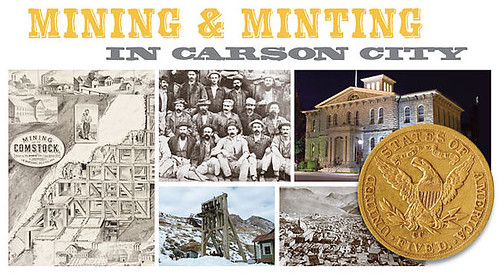
Go on a three-day educational adventure that explores the history of the Gold Rush in California and Nevada, tours the legendary Comstock Lode mines in Virginia City, and features top numismatic experts at the old Carson City Mint. "Minting and Mining in Carson City" is part of the American Numismatic Association's "Destination Education" series and takes place March 20-23 following the 2011 Sacramento National Money Show.™
Students will leave Sacramento by bus on Sunday, March 20 at 11 a.m., visit the Empire State Historic Park Museum and spend a night of fun and relaxation at the Peppermill Resort Spa and Casino in Reno. On March 21 students will tour the Comstock Lode, Virginia City, and other historic sites before arriving at the Courtyard Marriott in Carson City.
March 22 will be spent at the Nevada State Museum, formerly the Carson City Mint, learning from top numismatic experts before moving to the Nevada Governor's Mansion for a dinner featuring an appearance by Mark Twain. The seminar concludes March 23 with stops at Coloma and the Boeger Winery in Placerville before arriving in Sacramento by 2:30 p.m.
The cost of "Minting and Mining in Carson City," including tuition, transportation, three nights of lodging, meals and dinner credits, is $995 (single occupancy) and $1,549 (double occupancy). To register for the learning adventure of a lifetime, call 719-482-9850 or visit www.nationalmoneyshow.com.
Featured Experts:
Fred Holabird is the tour guide to the mines and towns of the Comstock Lode. Holabird has been a mining industry expert for 25 years, is well-published in mining publications and has been responsible for discovery and production at two Nevada gold mines.
Fred Weinberg, president of Weinberg & Co., leads a discussion of major U.S. Mint errors and the evolution of the coin error hobby. Weinberg was the only coin dealer to examine varieties among 2.5 million Carson City silver dollars at the U.S. Bullion Depository in 1973.
Bob Nylen, curator of history at the Nevada State Museum, explores the history of the Carson City Mint. Nylen has researched Nevada history for 30 years, developed the Kit Carson Trail Walking Tour and created many museum exhibits.
Gene Hattori, curator of anthropology at the Nevada State Museum, discusses excavations in Lovelock, Nevada that revealed U.S. gold coins beneath the city's former Chinatown. Hattori has worked on archaeological sites throughout Nevada and in San Francisco.
Ken Hopple, chief coiner at the Nevada State Museum, gives demonstrations of the historic Coin Press No. 1 that minted the first coins at the U. S. Mint in Carson City in 1870. Hopple has served as the operator of the press – an 1869 Morgan and Orr machine – for nine years.
For more information, see: http://www.nationalmoneyshow.com/index.php?id=110
QUERY: WHERE IS THE HAINES 1823/2 QUARTER?
 I'm researching 1823/2 quarter pedigrees and need some help.
I have been comparing plated auction catalogues with known coins and I am having a very hard time trying to identify the current location of the W.E.W. Haines Sale 10/13/1880:724 1823/2 quarter. The closest match I can come up with is the Byron Reed specimen. Does anyone have a named copy of the above sale? Any and all help is appreciated.
I'm researching 1823/2 quarter pedigrees and need some help.
I have been comparing plated auction catalogues with known coins and I am having a very hard time trying to identify the current location of the W.E.W. Haines Sale 10/13/1880:724 1823/2 quarter. The closest match I can come up with is the Byron Reed specimen. Does anyone have a named copy of the above sale? Any and all help is appreciated.
QUERY: IMAGES OF ENGRAVER WILLIAM BARBER SOUGHT
Ed Krivoniak writes:
Are there any surviving pictures of William Barber, the 5th Chief Engraver of the U.S. mint? I have found plenty of his son Charles E. but haven't been able to find any of William.
Dick Johnson wrote:
U.S. Mint Chief Engraver William Barber was a heavy set man. There is a tiny illustration of him -- but he is not identified -- in a group photograph of the engraving department on page 38 (it is Roman numeral "xxxviii" in the Introduction) of Robert Julian's "Medals of the United States Mint The First Century, 1792-1892." Barber is shown with mallet raised standing behind a table of medal dies in the center of the room.
This same image also appeared on a postcard in a set of sixteen interior photographs within the Third U.S. Mint building in Philadelphia shortly after the Mint moved into the new building at 16th & Spring Garden Street in 1904.
 Barbara Gregory, editor of the American Numismatic
Association's NUMISMATIST Magazine was able to provide a copy of the photo. But those were the days when The E-Sylum was a text-only publication.
I scanned the photo from my copy of Julian's book - it appears here.
Barbara Gregory, editor of the American Numismatic
Association's NUMISMATIST Magazine was able to provide a copy of the photo. But those were the days when The E-Sylum was a text-only publication.
I scanned the photo from my copy of Julian's book - it appears here.
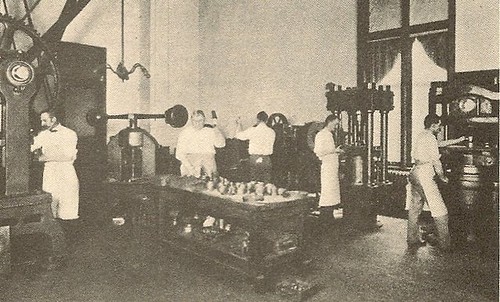
To read the earlier E-Sylum article, see: WILLIAM BARBER'S PICTURE AND PROFESSIONAL IMAGE (www.coinbooks.org/esylum_v09n44a05.html)
QUERY: NUMISMATOURIST HOWARD BERLIN SEEKS TRAVEL DESTINATIONS
It's 2011 and the Numismatourist (a moniker your E-Sylum editor bestowed on me several years ago) has completed a trip itinerary for this year, taking in several numismatic venues along the way. I'm asking for any assistance for those locations where I was unable to locate any numismatic museums, exhibits, or mints that are open to the public (free or $$).
March:
- Belgrade – any ideas?
- Zagreb – Muzej Grada Zagreba
May:
- Milan – Sforza Castle Museum
- Genoa – any ideas?
- Bologna – any ideas?
- San Marino – Coin & Stamp Museum; Museo di Stato
July:
- Berlin – covered all coin collections here in 8 previous visits; completing material for another book
August/September:
- Amsterdam – any ideas?
- Haarlem – Teylers Museum
- Utrecht – Geldmuseum
October/November:
- Jerusalem – The Bank of Israel; the Israel Museum (numismatic exhibit reopened); already have visited the Kadman Museum in Tel Aviv
MORE ON THE TENURE OF U.S. MINT DIRECTORS
In the actual interview (which went on for over an hour), I started with the generalization, then gave the specifics. I give you that Donna Pope served her full term, but Bush I made it clear that David Ryder was his man -- and used a rare recess appointment to prove it.
Scott wrote: "Eva Adams, appointed by Kennedy in 1961, was reappointed by Johnson in 1966, and resigned in August 1969 after Nixon was in the White House".
Eva knew the rules better than anyone. The term is for five years, but you are part of the Administration, and she offered her resignation to LBJ right after the assassination (he declined it and for that reason he re-nominated her; those who tried to keep their appointments made under JFK suffered and were eased out]. Anyhow, when Nixon took office on January 20, Eva knew that the Philadelphia Mint (which she had been a strong advocate for) would open that summer; she also knew Nixon from her days working on the Hill for Sen. Pat McCarran.
The Nevada Women's History web site simply says "She served on boards of directors of several corporations and foundations and was a consultant to the Chairman of the Board of Mutual of Omaha. In 1969 she resigned from the U.S. Mint when President Nixon came into office and wanted a Republican for the position. After retirement she continued working for Mutual of Omaha in Washington for a time, but ultimately retired to Reno"
Not that long ago, I wrote "Her proudest and most lasting accomplishment as director was in the creation of a new Mint at Philadelphia, which opened in August, 1969, at the conclusion of the ANA summer convention, held that year in Philadelphia.
The new facility, then the largest and most modern in the world, was shown in a rare floor tour to attendees of the ANA Convention. One major press -- the General Motors coin roller -- was the technology around which the Mint was predicated.
It ultimately turned out to be a failure, incapable of producing coins at the rate of tens of thousands per minute, compared with the 600 coins per minute then the industry standard used in the Denver Mint and San Francisco Assay office.
Although Adams was appointed to a five year term, she understood the politics of the job, and was pressured by President Nixon, who took office January 20, 1969, to conclude her term before it expired in 1971. She held on through the opening of the Philadelphia Mint, and introduced her successor, Mary T. Brooks, as well as Treasury Secretary David M. Kennedy, to the assembled crowd."
Anyhow, Eva made her deal with Nixon and did get to stay, but she understood the dynamics and had to depart.
To read the earlier E-Sylum article, see: ON U.S. MINT DIRECTOR TENURES (www.coinbooks.org/esylum_v14n02a13.html)
WHERE ARE THE ELECTRONIC NUMISMATIC BOOKS?
The future of content consumption is electronic. E-book readers will support the reading of books, magazines, newspaper, and some online content on a small handheld device conveniently sized for reading. They are designed to do one thing very well: provide you a way to read published content in a more convenient manner and without killing trees. While tablet and smart phones are more general devices, both have the ability for you to read published works when you are not playing the current hot game or social networking. All of these devices have programs that can tap into online bookstores so that you can buy books at a reduced price and have it loaded directly onto your device to read.
E-book readers can read many different format files, but the type used for the best reading experience is based on the concept of "electronic paper." Electronic paper allows the reader to resize, bookmark, type notes, highlight, and do anything to an electronic page except fold it while maintaining the integrity of the book. As the read changes size or add their own notes, electronic paper allows the book to reflow, or repaginate, within the device. When a book or document is repaginated, tables of contexts and indices are also adjusted to make the text easy to search.
Currently, the only numismatic book publisher selling electronic versions of their books is Krause Publications. If you visit their online store you can search the Coin CDs/DVDs section to find a number of their publications, including the Standard Catalog series can be purchased on CD. Once you load the CD on your computer and copy the Portable Document Format (PDF) file to your hard disk, you can open the file in a PDF reader (Adobe Acrobat Reader on any system or Preview on a Mac). Once the file is open you can search for any text, zoom in to view any image up to 400 percent, add notes, bookmark pages, and highlight areas. Again, anything you can do with a real book except fold page corners.
Krause also sell sections of the Standard Catalogs and other publications as downloads. For example, if all you are interested in are Obsolete Bank Notes of the District of Columbia, you can just download that section of the Standard Catalog of United States Obsolete Bank Notes for significantly less than the entire four CD set.
Since I purchased the Standard Catalog of World Coins for the 20th century, it has been a wonderful resource to have while sitting at my computer. Searching for country coinage information and making highlights has really enhanced my appreciation for the work without having to lug around that huge volume. I also consider how many trees were saved by buying bits and not pulp.
At least Krause has taken the first step into electronic publishing. Whitman Publishing, the other major publisher of numismatic books, only offers "dead tree editions." I know that some people like the physical book, but they should start embracing the 21st century and offer e-books for those of us who want to read their books in a more portable format that does not kill trees. I am sure Whitman can figure out the economic benefits of replicating bits over importing physical copies from China.
Until Whitman and other numismatic publishers catch up with the e-reader, you can find classic electronic books to download to any device. The best source if Google Books. While Google Books does sell current editions in electronic format, they also have a number of scanned books they have permission to make available or whose copyrights have expired. The best way to find numismatic books is search for "coins" on the Google Books website. Books can be read online or you can download free books through the Google Bookstore. You can file early copies of The Numismatist through Google.
Publishers who have not embraced the e-reader will lose out on the business of younger numismatists and technology-oriented people like myself. CES made it clear that the future is in portable electronic devices and the publishers who cannot or will not provide the appropriate product will be losing out on new business. I hope the numismatic publishers consider this for their current and future publications
To read the complete article, see:
Where Are the Electronic Numismatic Books
(coinsblog.blogspot.com/2011/01/where-are-electronic
-numismatic-books.html)
Scott adds:
I am amazed at the response from this post! I must have hit a nerve with some people on both sides. There are those who love the physical paper versions, but the overwhelming number of people want more electronic versions. I may have sold some CDs for Krause... and I do not receive a commission.
I also received a note from someone at Whitman telling me that their "Encyclopedia of U.S. Paper Money" and the Professional Edition of the Red Book are available on a DVD.
Whitman Publishing has already made some forays into electronic publishing. Dave Bowers's magisterial Whitman Encyclopedia of U.S. Paper Money is available on DVD (Mac and PC compatible), in the format of a searchable PDF with internal links. It's amazing what can be stored on a thin, lightweight, eminently portable disk --- in this case, 900 pages of historical research, market prices, auction records, more than 1,600 high-resolution color photographs. . . all the width and depth that Bowers is famous for. (Here's a link: http://www.whitmanbooks.com/Default.aspx?Page=81&ProductID=0794830455.) The first Professional Edition of the Red Book was also available on DVD --- again, a huge amount of numismatic data and research.
The publishing world has made great leaps in recent years in terms of electronic distribution of content, with PDFs, apps, downloads, online push and pull broadcasting and narrowcasting, etc. We're continuing to explore and develop electronic distribution, and we'll announce new projects as we roll them out.
We also have two free web sites, WhitmanReview.com and WhitmanCoinCollecting.com , that publish show reports, book reviews, numismatic interviews and commentary, auction news, and other hobby information on a regular basis. And collectors can follow us on Twitter and Facebook at WhitmanCoin.
Scott Barman and I were discussing book reviews this week; here are some musings I sent him.
Remember in the early and mid-1990s, when "CONTENT IS KING" became the mantra of every Internet consultant and Web design agency from coast to coast? It's still a very important concept in numismatic publishing. Whitman is strongly devoted to supporting fresh, ongoing, original numismatic research and authorship. This of course includes updated retail and wholesale pricing (as found in the Red Book and the Blue Book), updated auction records, updated certified coin populations, and the like. Those kinds of market data are very important to collectors, dealers, and investors.
But Whitman Publishing has a commitment to the hobby community that goes beyond just reporting on market trends. We've nurtured a booming renaissance in numismatic publishing over the past ten years or so in particular. That investment, that energy, that explosion of talent has created the CONTENT; without good content, distribution models (whether ink-on-paper or electronic) are irrelevant to the hobbyist. If the content is factually wrong, or if it's incomplete or misleading, or if it's just a stale rehashing of old previously published information, it won't matter if it's published in books or online --- collectors won't find it valuable. Neither the publisher nor the consumer will find true, lasting value in that formula.
Whitman Publishing has the best numismatic authors and researchers working today. Kenneth Bressett, Q. David Bowers, Jeff Garrett, Dick Doty, Roger W. Burdette, David W. Lange, Rick Snow, Mike Moran, Bill Fivaz, J.T. Stanton, Katherine Jaeger, Rick Tomaska, Nicholas Brown, David Camire, Fred Weinberg, David Sundman, Harlan J. Berk, Clifford Mishler, Jim Haxby, Art Friedberg, Ron Guth, John Dannreuther, Hugh Shull, George Tremmel, Robert Azpiazu, Ira and Larry Goldberg, Eric P. Newman, Paul Rynearson, David MacDonald, Don Bailey, Scott Schechter, Saul Teichman, Fred Reed, Adam Crum, Selby Ungar, Jeff Oxman, Frank Colletti, Bob Leonard, Len Augsburger, Joel Orosz --- that constellation of numismatic stars shows Whitman's commitment to content.
How we deliver that fresh, original content will continue to evolve. And it won't end with the current generation of numismatic superstars. Last year Whitman teamed up with the American Numismatic Association to revamp and endow three new literary awards for Young Numismatists. They'll be the ones digging in Treasury archives, unearthing primary documents, analyzing data, making brilliant connections, and writing about their findings after we all retire.
Is the traditional paper book obsolete? No. Are distribution models changing? Yes. Will Whitman Publishing continue to bring its best to collectors and serve their needs? Yes indeed!
DIGITAL LIBRARY NUMIS UPDATE
 Digital Library Numis (DLN) has been transferred to a new and much more improved platform:
Digital Library Numis (DLN) has been transferred to a new and much more improved platform:
http://sites.google.com/site/digitallibrarynumis
Also, additional information on DLN and recent updates can from also be consulted at Academia:
http://independent.academia.edu/ThijsVerspagen
Welcome to Digital Library Numis (DLN). This website is dedicated to the study of numismatics and it's main objective is to establish a major portal and open access repository for digital publications regarding coins, medals, monetary history and related subjects.
DLN was initially developed primarily to provide an extensive compilation of many rare, often beautifully illustrated numismatic classics, printed from the 16th until the early 20th century, which can be downloaded or reproduced, without any copyright limitations.
But as more and more authors and publishers nowadays are starting to offer their books and essays for free, you will also find here a continually growing amount of references to contemporary items available online.
DLN is in particular useful as a additional research tool for numismatists, but also for historians, other scholars interested in the field, branch libraries and collectors.
To read the earlier E-Sylum article, see: WEB SITE: DIGITAL LIBRARY NUMIS (www.coinbooks.org/esylum_v12n22a10.html)
CAN A PUBLISHER BE SUED FOR ERRORS IN A BOOK?
Can a publisher be sued for errors in a book? Maybe. The State of Virginia has a problem. Its Department of Education had discovered two books published by Five Ponds Press here in Connecticut that contain so many errors that it is seeking compensation from the publisher for the costs of the books it had purchased.
The two books are "Our Virginia: Past and Present" and "Our America: To 1865." They are used as textbooks in fourth grade history classes in Virginia schools. Five historians examined the books page by page and found errors of wrong dates, factual errors, inaccuracies, false statements, misspellings and punctuation errors.
One reviewer stated he feared the books could "undermine schools' efforts to teach proper language and writing skills."
Author of "Our Virginia" (and five other books by the publisher), Joy Massif, had previously stated she obtained the misinformation on the internet.
What does this portend for numismatic writers? Fact check everything. And don't rely on what you find on the internet. Remember, anyone can put anything on the internet.
Professional publishers demand accuracy from their authors, but also exercise due diligence, seasoned editing, and proofreading before it places anything in print. You don't have that vetting on the web.
You'll find more in the news story:
Virginia Board of Education presses publisher of mistake ridden textbooks
(www2.godanriver.com/news/2011/jan/13/3/virginia-board
-education-presses-publisher-mistake-ar-772546/)
NOTES FROM E-SYLUM READERS: JANUARY 16, 2011
E. Tomlinson Fort writes:
I liked Dick Johnson's note on the Churchill crown. His criticisms of Todd Sciore's article in The Numismatist would appear to be spot on, if the work — I have not read it — is as he says. However, while he is right to criticise the author there are some important people he forgets — namely the Editor and the publication's outside reviewer(s). If all of these people missed those mistakes and allowed this work to see print then they are as liable as Sciore.
In general though, standards are high for print publications, and I don't envy the task of their editors. It's a tough job. There are hundreds of ways to draw criticism, and few accolades when you get everything perfectly right - that's when nobody even notices.
Dick's criticism of the author's omission is fair - just be sure to acknowledge the good work of all involved in producing a major numismatic periodical on a regular monthly basis.
Also be aware of another problem that Dick himself has identified in the past - author paralysis. It's when the quest for perfection leads to an inordinate delay or precludes publication entirely. I'm guilty of that myself. In fact, I had a decent manuscript for an article for The Numismatist on Dickin medals that the editors wanted to publish as part of a special issue on dogs in numismatics. I demurred, not feeling I'd done enough homework yet to justify going to print. The issue came and went without my article. It was an excellent issue, and I regret not being a part of it. Dick is right to encourage authors to be wary of letting their quest for perfection preclude publication in the first place. It is sometimes better to publish first and correct later than never to publish at all.
-Editor
To read the earlier E-Sylum article, see: WINSTON CHURCHILL ON COINS AND MEDALS (www.coinbooks.org/esylum_v14n02a10.html)
Regarding chocolate coins, David Gladfelter writes:
If I could read your mind, you are about to ask us, what other pieces of exonumia struck in chocolate do we know about? Well, a 76mm gold foil chocolate filled medal of President Kennedy made it into Edward C. Rochette's Medallic Portraits of John F. Kennedy (Krause Publications, Iola WI, 1966) and is catalogued as item K-63A-10. You don't want to let that one get too near the stove.
And, as Alberto F. Pradeau tells us, cacao beans circulated as money in pre-colonial México and "remained as a monetary unit in New Spain until the opening of the nineteenth century." Numismatic History of Mexico, English edition (Los Angeles, published by the author, 1938), pages 10-11.
To read the earlier E-Sylum article, see: TREASURE IN THE CELLAR CHOCOLATE COINS (www.coinbooks.org/esylum_v14n02a09.html)
Bob Leonard writes:
The "Spanish silver doubloon" of 1791 found under the Bluenose mainmast is of course a bust type 8 reales of the Mexico City mint.
To read the earlier E-Sylum article, see: STEPPING THE MAST: COINS OF THE BLUENOSE II (www.coinbooks.org/esylum_v14n02a20.html)
MORE ON THE SHERATON COIN COMPANY
Dan Hamelberg writes:
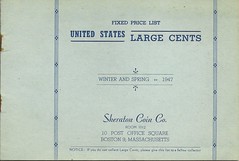 I have a copy of the Sheraton fixed price list as illustrated in The E-Sylum. It's the same date and format. I purchased it 20 years ago in a Charlie Davis sale. It is the only price list from Sheraton that I could find in my library.
I have a copy of the Sheraton fixed price list as illustrated in The E-Sylum. It's the same date and format. I purchased it 20 years ago in a Charlie Davis sale. It is the only price list from Sheraton that I could find in my library.
Ernest P. Henderson (1897-1967) founded the Sheraton hotel chain, a collection of older hotels that he acquired over a period of time, following the same business plan used by Conrad Hilton. Henderson used a style of antique furniture as the name.
By 1945, Henderson and his friend and business associate, Robert L. Moore, had become dedicated collectors of large copper cents. They had scouted around for several years, buying choice examples when found, including from Dr. William H. Sheldon. Moore had a passion for early coppers, while Henderson was, shall I say, quite interested.
They had discussions with three Boston coin dealers—Maurice M. Gould, Frank Washburn, and Harold Whiteneck. Gould and Washburn ran the daily operations, and Whiteneck was an advisor. The business plan was to buy needed cents for the collection of Henderson and Moore, and to build an inventory starting with their duplicates. It was hoped that estates and major collections could be acquired intact. The office was in Room 1012, 10 Post Office Square, Boston.
Tiring of the pursuit, Henderson consigned his main collection to the Numismatic Gallery (Abe Kosoff and Abner Kreisberg), who billed it as the Sheraton Collection in the summer 1947 ANA convention auction held in Buffalo. The highlight was the finest known 1799 cent, the Henry Hines specimen, About Uncirculated, which realized the impressive price of $1,500 in a "down" market in the hobby. Many other choice Hines cents were offered as well.
Gould and Washburn formed the Copley Coin Company, on Boylston Street, Boston. When I first visited there, in 1957, they had hundreds of large cents and other coins still in Sheraton Coin Company envelopes. I came to be fine friends with each of them, and in time bought Maury Gould's collection of counterstamped copper cents.
Maury was a "people person," a familiar figure at coin clubs and a promoter of the hobby. After he retired he relocated to California, where he remained prominent, although no longer dealing. He was a columnist for Coin World. Frank was quieter, more of an office person than a meet-and-greet ambassador. Later, he had some money problems. I recall buying some coins he had held back, but, unfortunately, they were not of great value.
Harold Whiteneck conducted a mail order business then, later, the Court Coin Co. at 20 Court Street in Boston. He had a pilot's license and in the summer would fly to a camp he owned in Maine.
At the American Numismatic Association convention in Boston in the summer of 1960 Henderson spoke at the banquet. Listeners hoped to hear anecdotes about early coppers, but reality was different—a talk that droned on and on about the hotel business and other matters, and no interesting numismatic stories at all. About this time Moore sold his memorable collection of 1794-dated cents privately to Dorothy I. Paschal and Eugene ("Gene") Exner, who split them up.
The Sheraton Coin Company today is but a footnote in American numismatic history, but an interesting one with highly accomplished principals.
To read the earlier E-Sylum article, see: ROBERT HENDERSON AND THE SHERATON COIN COMPANY (www.coinbooks.org/esylum_v14n02a18.html)
QUERY ANSWER: ANA HALL OF FAME BIRTH, DEATH DATES
Steve M. Tompkins writes:
Here is what I was able to find with very little searching, hope it helps.
- Ole Eklund: (1873 - 1950) Found on Wikipedia
- S. Wolcott Freeman: (1906 - 1967) Found on the ANA Web site
- Barclay Head: (1/2/1844 - 6/12/1914) Found in The Asylum IX-4 pg 10/11
- B. Max Mehl: (11/5/1884 - 9/28/1957) Found online (www.findagrave.com)
- Stuart Mosher: (1904 - 1956) Found in the American Numismatic Society archives (his name was spelled Stewart)
Phil Iversen independently found the November 5, 1884 birth date for B. Max Mehl from a different source.
Ken Bressett writes:
I found Barclay Head's birth and death years in a book on ancient coins. I looked the others up on the Internet initially, but then I dug out an ANA publication that lists all Hall of Fame members with birth and death dates so that I could verify everything. This is what I found:
- Eklund 1873-1950
- Freeman 1906-1967
- Head 1844-1914
- Mehl 1884-1957
- Mosher 1904-1956
To read the earlier E-Sylum article, see: QUERY: BIRTH DATES OF ANA NUMISMATIC HALL OF FAMERS (www.coinbooks.org/esylum_v14n02a14.html)
JOHN SINNOCK AND THE PURPLE HEART
I didn't fact-check this. Not that I ever fact check much of anything in The E-Sylum. But thankfully, we have knowledgeable (and vocal) readers to set us back on the straight and narrow. Ed Reiter provided the following background on this important medal. -Editor
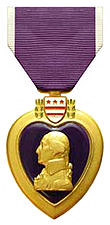 I'm sure Dave was thinking of John Sinnock, not Frank Gasparro, when he wrote about the U.S. Mint's involvement with the Purple Heart.
I'm sure Dave was thinking of John Sinnock, not Frank Gasparro, when he wrote about the U.S. Mint's involvement with the Purple Heart.
However, it would be an exaggeration, if not an outright misstatement, to say that Sinnock designed it. It's not unlike the Mint's assertion that its own staff artists "designed" the state quarters when all they did in many cases was execute designs created by outsiders.
Gen. George Washington "devised" the original award -- a Badge of Military Merit, which he specified should consist of purple cloth or silk in the form of a heart edged with narrow lace or binding. Recipients' names were to be inscribed in a Book of Merit. As it turned out, Washington awarded this badge only three times during the then-waning days of the American Revolution and it fell into disuse thereafter, despite his stated wish that it should become a permanent form of recognition for battlefield valor.
In the late 1920s, with the bicentennial of Washington's birth drawing near, efforts were made to revive the award, and a bill to accomplish that was introduced in Congress. But the legislation made little headway and was withdrawn. It took another formidable Army commander, Gen. Douglas MacArthur -- then the Army's Chief of Staff -- to marshal the needed support. On Feb. 22, 1932, Washington's 200th birth anniversary, the award was officially revived "out of respect of his memory and military achievements."
The Army Office of the Quartermaster General was responsible at that time for preparing military awards and medals, and the task of designing the updated version of what came to be known as the "Purple Heart" was assigned to Elizabeth Will, one of two heraldic artists in that office. John Sinnock, then chief sculptor-engraver of the Mint, was commissioned to refine the design and mold a plaster model.
The modern Purple Heart consists of an inner heart made of purple plastic (originally enamel) atop a larger outer heart of gold-colored metal. On the purple inner heart, General Washington is shown in left-facing profile and his portrait is in gold-colored metal and raised relief. Above this heart is Washington's coat of arms -- an enamel shield of white with two horizontal bands of red. Above these are three red stars with sprays of green leaves on either side of the shield.
The reverse of the outer heart bears the three-line inscription "For Military Merit," with a space below for the recipient's name. The medal is attached to a ribbon colored deep purple with narrow white edges.
Although Sinnock didn't "design" the Purple Heart in the sense that he designed the Roosevelt dime and Franklin half dollar, he did make important modifications to Elizabeth Will's design -- notably by replacing a leaf in the center of the inner heart with Washington's profile.
The award is conferred on any person wounded in action while serving with the U.S. armed forces. It also is presented posthumously to the next of kin of personnel killed in action or who died of wounds suffered in action. To qualify, a recipient must have died or been wounded as a result of an act by any opposing armed force, in an international terrorist attack or during military operations while serving as part of a peacekeeping force.
To read the earlier E-Sylum article, see: QUERY: DID THE U.S. MINT MAKE EMBLEMS FOR THE MARINE CORPS? (/www.coinbooks.org/esylum_v14n02a15.html)
THE BOOK BAZARRE
PARKS CANADA COIN DESIGNER LUC NORMANDIN
I visited the Canada Mint web site last week and viewed the video which accompanies the offering. This video features an interview with the designer, who stated he had never designed a coin and that he chose images from books and the Internet to draw from and that is where he found his inspiration.
Link to Mint video:
www.mint.ca/store/artist/luc-normandin-10800035?cat=
Meet+The+Artist&nId=4600002&parentnId=&nodeGroup=Learn&lang=en_CA
or on YouTube
http://www.youtube.com/watch?v=RLRTFCpDKIc .
To read the earlier E-Sylum article, see: PARKS CANADA COIN CRITICIZED (www.coinbooks.org/esylum_v14n02a22.html)
MCLEANS PUBLISHES A TRIBUTE TO THE CANADIAN CENT
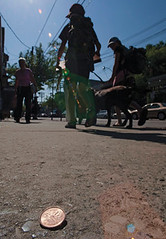 As Canada is nearing abolishing its cent coin, the Canadian publication McLeans has published an excellent article on the coin. Authored by Nicholas Kohler and titled "A Penny Dropped," the article is not only a history of the cent -- with a modicum of lore that collectors love -- it is amazingly full of facts. This is the kind of story that an intelligent public should have at hand before making the final decision to eliminating the coin.
As Canada is nearing abolishing its cent coin, the Canadian publication McLeans has published an excellent article on the coin. Authored by Nicholas Kohler and titled "A Penny Dropped," the article is not only a history of the cent -- with a modicum of lore that collectors love -- it is amazingly full of facts. This is the kind of story that an intelligent public should have at hand before making the final decision to eliminating the coin.
The article is not what is usually encountered by non-numismatic writers. The author did a superb job in this report. It should also be preserved in every numismatic library for every collector of this country's coins for all time to come.
Coppers, as they were called, remained for years a phenomenon of Canada's East—unpopular beyond Ontario and an early emblem of western distaste for Toronto, Ottawa, Montreal. "You left Ontario, the coppers became worthless," says Ian Laing, president of Winnipeg-based Gatewest Coin Ltd. "People gave them away as they left." Attitudes toward the cent were still antagonistic as late as 1905, when Jack and Timothy Eaton opened a five-storey Eaton's in Winnipeg, where retailers had banded together to keep the penny out by pricing goods to the nickel. When Jack, a stickler for such things, decreed his prices on Portage Avenue would be the same as in Toronto, he sent $500 worth of one-cent coins to Winnipeg. Beside each cash register, he set up charity boxes so customers could discard them should they wish. But he began to sell newspapers at two cents rather than five. Soon, all of Western Canada was awash in pennies.
It's easy to forget the Canadian one-cent coin, modelled after the decimalized, very practical U.S. penny (introduced in 1793), once represented an improvement—and not just over the maddening abacus of British denominations, with all those 240 pence required to count out a pound. In 17th-century Newfoundland dried cod was used as currency—likely so that poor Newfoundlanders might emulate the stinking rich. Moose hides and gold dust, molasses and wheat have all at one place or another been used as money in Canada. So have Portuguese escudos, old French livres, Dutch guilders, U.S. pennies stamped with a long-haired Liberty, and Spanish dollars, often cut into eight bits to make change (hence the expressions, "two bits," meaning a quarter, and the "pieces of eight" of pirate lore). Brass coat buttons, de-shanked, flattened and stamped, were enlisted as currency, and an archaeological dig in Quebec unearthed an ancient Greek bronze as part of an early settler's pocket change. "It just shows you money always has some value to somebody," says Paul Berry, chief curator of the National Currency Collection, part of the Currency Museum at the Bank of Canada.
If you are interested in Canadian coins, don't waste a moment in reading this article: A penny dropped (www2.macleans.ca/2011/01/14/a-penny-dropped/)
AN 1864 WATT AND COMPANY HONG KONG TRIAL PIECE
Kerry Rodgers writes:
Have a look at the latest Spink Hong Kong note 'n coin sale catalog - Lot 622. A lovely bit of history - I have never seen one illustrated before. It's interesting trying to align the date shown with the Soho Mint's story. I must look up my Birmingham Mint history. And why retrograde legends?
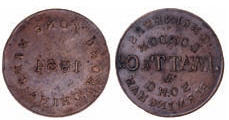
Hong Kong, AE medallic trial piece, 38.5mm., J Watt and Co, Soho, Birmingham, retrograde legends, 1864, date, HONG KONG MINT CHINA, rev. J.WATT AND CO., above ENGINEERS, LONDON, below & SOHO, BIRMINGHAM, edge plain (Prid. 321), edge knocks, very fine, rare HK$6,000-7,000
This is a machine trial piece by J Watt and Co struck to test a coining press they manufactured for the Hong Kong mint which was later used to strike the Hong Kong silver dollars. Specimens exist with both a plain and an engrailled edge.
To read the complete lot listing, see: Banknotes & Coins of Hong Kong & China (22nd Jan 2011) (www.spink.com/auctions/pdf/11003.pdf)
THE MOST BEAUTIFUL DEPICTION OF A SHIP IN NUMISNAUTICS
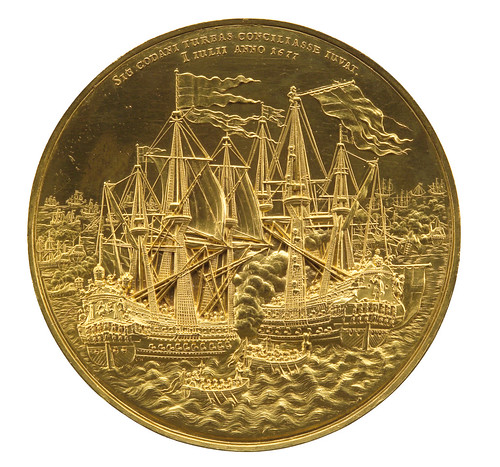
The medal was produced during the Scanian War, which had broken out in 1675 and had came to an end when the Peace of Lund was declared in 1679, which rooted in the opposition between France and Brandenburg.
The translated multiline legend under the monogram reads as follows:
"After, by divine providence and under the lucky reign of the most noble and most powerful prince and master, King of Denmark, Norway, the Vandals and the Goths, Duke of Schleswig, Holstein, Stormarn and Dithmarschen, Count of Oldenburg and Delmenhorst, the enemy fleet was defeated three times, I at Öland, II at Langeland, III at the Køge bay, and after eleven war ships of the heaviest kind together with all their equipment were captured, this crown was won."
The legend refers to the three naval victories of Denmark under Admiral Niels Juel over the Swedish fleet in 1676 and 1677, namely the victories of Øland (June 1st, 1676) and Langeland (June 1st, 1677) as well as the one of the Køge bay south of Copenhagen (July 1st, 1677). The legend is parted by a corona navalis, a head gear with the foreparts of ships reserved for victors at sea, which the legend explicitly refers to.
The reverse shows the naval battle at the Køge bay, it is the most magnificent depiction of a ship on a medal known to exist. The artist's signature can be read on the ship painted on the left-hand side. Designing this piece, the medallist Christoph Schneider who presumably came from Germany and worked in Copenhagen created the largest struck medal ever. Although some pieces of comparable size were produced in the 18th century (amongst others by Friedrich Marl in Berlin in 1719), this one is the undisputed gold giant of historical medals thanks to its enormous weight.
It is hard to surpass its technical and artistic execution with the relief being unusual high for struck medals. The die cutter distinguishes himself by his extraordinary passion for detail and accomplishes a marked depth effect with the contrast of the plastic three-dimensional ships in the foreground and the flatter cutting in the background. This representational medal belongs to the old inventory of the collections of the House of Habsburg. Admittedly, its origin is unknown but a high of number of gold medals of highest quality were incorporated into the Imperial inventory with Franz Stephan of Lorraine from Lorraine works of art.
This gold giant can be viewed in the exhibit of the Berlin Coin Cabinet bearing the same title. For more information click here .
To read the complete article, see: The most beautiful depiction of a ship in numisnautics (coinsweekly.com/en/Article-of-the-week/5)
C-SPAN VIDEO: HISTORY OF U.S. CURRENCY
Franklin Noll talked about the history of United States currency. He showed various artifacts in the Historical Resource Center of the Bureau of Engraving and Printing to tell the story of American paper money, which was introduced nationally as "greenbacks" during the Civil War as a means to pay for the expenses related to the conflict. Photographs and clips from a Bureau of Engraving and Printing video and a 1933 Universal newsreel were also shown in the background.
To view the complete video, see: History of U.S. Currency (www.c-spanvideo.org/program/SCur)
FEATURED WEB PAGE: GERMAN STATES COINS
This week's Featured Web Page is the German States coins page of the mycollecting.net web site.
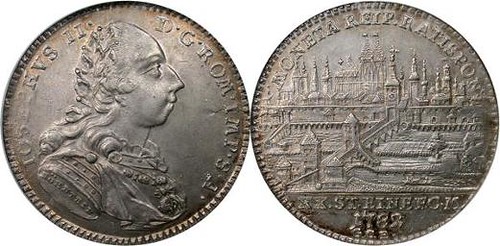
I have become quite enamored of the German States coinage of the 17th-19th C., there are some appealing designs and very low prices with the minors. This period was full of great men, famous battles, and just very interesting history.
As for costs, most of these are priced at $25-500 in the market, however some of them do not show up in the marketplace more than once or twice a year so you have to be ready to jump on them.
www.mycollecting.net/9.html
